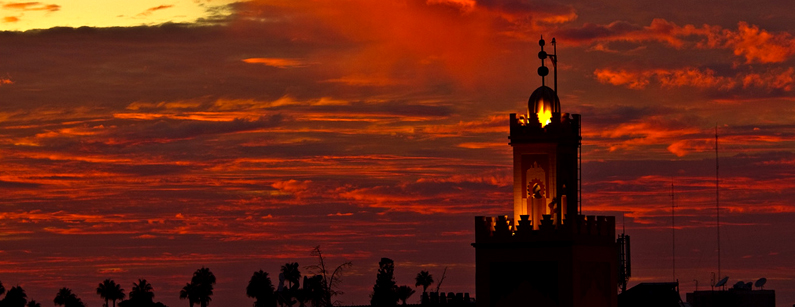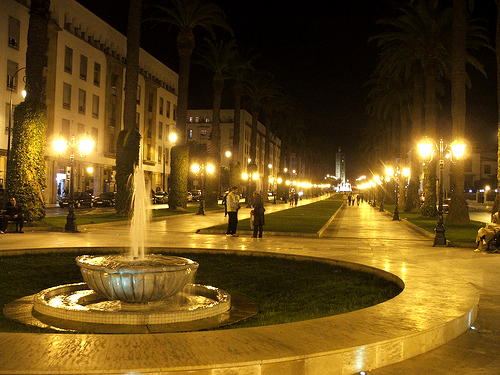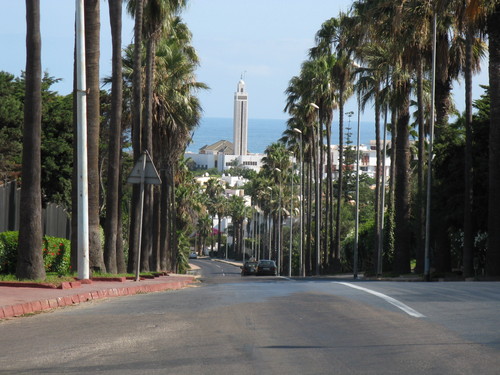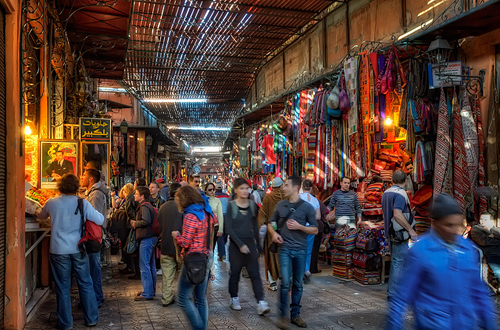A brief
introduction to magical Morocco and its culture

|
Sky
over Marrakech CC BY-NC 2.0 Elvin
|
Sitting
on the northwestern tip of Africa, Morocco is a unique location and is,
in many ways, a country apart from the rest of the continent. This exotic
destination is separated from other African countries by the stunning and
beautiful Atlas Mountains and the endless sands of the Sahara desert, with
lush valleys and fascinating cities in between.
If
planning a visit to this country, Lawrence
of Morocco offers great tailor-made trips, planned down to the finest
detail and the following gives you a brief introduction into how the mixed
and exciting culture of Morocco came to be.
Culture
Mix of Morocco
Morocco
has more of a feel of the Mediterranean countries than it does Africa or
the Middle East and its cities are a fascinating mix of the classic old
traditions and more modern times. On the Mediterranean coast, visitors
can enjoy the fine sandy beaches and warmer ocean, while in the north beautiful,
green highland valleys await and in the south, stark landscapes of the
Atlas mountains loom over the terrain, while the sands of the Sahara stretch
across the horizon. The Atlantic coast offers more sandy beaches
and cooler water but no less fascinating cities to visit.
The
culture of Morocco is also a mix, emanating from the various peoples who
have lived there over the centuries. Originally inhabited by the
wandering Berbers, Morocco saw the Romans taking over in 146 BC and Roman
ruins can still be visited today in Volubilis.
As
Rome went into a decline, the Vandals, an East Germanic group of tribes,
moved in. In the 7th century, Morocco was taken by the Arabs. While the
latter ruled the country for only just over a century, the culture of Islam
has remained as a permanent feature in Moroccan culture.
From
then onwards several different dynasties came into power, followed by the
arrival of the Spanish and Portuguese in the 15th century, shortly after
they successfully removed the Moors from their own lands. In each
case, Morocco did manage to successfully keep its heritage but European
imperialism continued into the 19th century.
It
was France's turn next as in 1911 the French became protector of the majority
of the country, while Spain managed to hang on to a few isolated portions
of Morocco. Finally, in 1953, French rule was over, although its influence
can still be felt today and many people in Morocco still speak the French
language. Nowadays Morocco is a kingdom ruled by King Mohammed VI, who
has brought the country to a level of economic prosperity and long-term
stability.
All
the various nationalities that have been a part of the country's past can
still be felt today in the imperial cities of Morocco. The following
is a brief introduction into three of the major cities, all worthwhile
visiting.
The royal
city of Rabat

Downtown
Rabat CC by-SA 3.0 farm1
The
political
capital is Rabat, which is situated on the Atlantic coast of Morocco.
A mix of modern capital with historic city, Rabat is listed as a World
Heritage site. The Medina is the older part of the city. The new town is
among the largest and most ambitious urban projects in Africa and includes
the royal and administrative areas of the city along with commercial developments
and the lovely Jardins d'Essais botanical gardens.
Charming
Casablanca

Boulevard
du Lido Casablanca CC by-SA 3.0 Othmanlah
Morocco's
largest city is Casablanca,
which also nestles on the Atlantic coast. The city is Morocco's chief port
and industrial center. Main sites worth a visit are the Ville Nouvelle
(New Town) from the French period. In this area, modern hotels and
administrative buildings can be seen, all built in a combination style
of Art Deco and Hispano-Mauresque. On the Atlantic promontory, the Hassan
II Mosque stands proudly. The mosque has the world's tallest minaret, at
210 metres.
The
city's largest public park is Parc de la Ligue Arabe, a restful and leafy
area, great for a stroll, and close by can be seen the Cathédrale
Sacré-Coeur, or Casablanca Cathedral, a great example of Mauresque
architecture. For a modern shopping experience, the Casablanca Marina
is worth a visit.
Marvellous
Marrakech

Souk
in Marrakech CC BY-NC-SA 2.0 Marc
Located
to the north, up in the Atlas mountain foothills, lovely Marrakech is a
place of fascination. Marrakech
is probably the most important of the four former imperial Moroccan cities
(built by the Berber empires). In the 1960s and 1970s, Marrakech became
somewhat of a hippie mecca and that vibe can still be felt today in certain
parts of the city.
A myriad
of palaces, museums and mosques await in the city, each with evidence of
past history. As with all the Moroccan cities, the old fortified city (the
Medina) offers many vendors selling their wares and on top of this, Marrakech
has 18 souks, where thousands of people make and sell copperware, leather,
pottery and other craftwork.
In
conclusion, Morocco is a great destination for a vacation or holiday with
much to offer for all tastes and budgets. Here you can eat, drink
and shop until you drop, all the while taking photos to treasure for a
lifetime.
top


|

